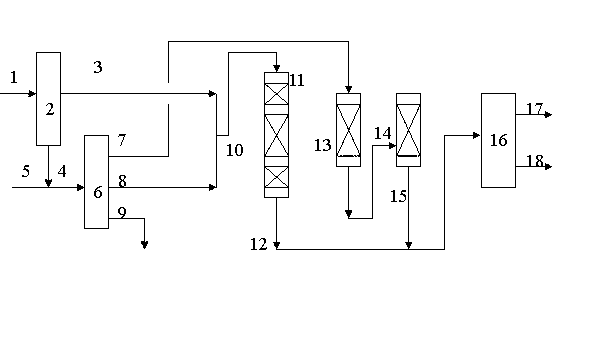Method for producing clean fuel oil from ethylene tar
A technology of ethylene tar and fuel oil, applied in the field of combined process of delayed coking and hydrogenation, which can solve the problem of poor quality of liquid products - coker gasoline, diesel oil and wax oil, low yield of liquid and light fuel oil products , Ethylene tar fraction has not been effectively dealt with and other problems, to achieve the effect of expanding raw material sources, improving utilization rate, and improving economic benefits
- Summary
- Abstract
- Description
- Claims
- Application Information
AI Technical Summary
Problems solved by technology
Method used
Image
Examples
Embodiment 1~3
[0043] use figure 1 process. Ethylene tar was distilled into light fraction and heavy fraction, with 420°C and 480°C as cut points, respectively, to obtain light fraction and heavy fraction after distillation. The properties of the vacuum residue are listed in Table 1. Table 2. The obtained ethylene tar heavy fraction was mixed with the vacuum residue, the mixed raw material and its delayed coking process conditions, and the properties of the obtained gasoline and diesel fractions are shown in Table 3. See Table 4 for coking gasoline hydrotreating pre-refining and hydrofining process conditions. In the embodiment, the coker diesel oil fraction is mixed with the ethylene tar light fraction, and the light fuel oil is obtained through hydrotreating. See Table 5 for the hydrotreating process conditions. In the example, two reactors are used in series for the hydroprocessing reactor, one is filled with hydrogenation protection agent FZC-103 and hydrofining catalyst 3936 from top...
PUM
 Login to View More
Login to View More Abstract
Description
Claims
Application Information
 Login to View More
Login to View More - R&D
- Intellectual Property
- Life Sciences
- Materials
- Tech Scout
- Unparalleled Data Quality
- Higher Quality Content
- 60% Fewer Hallucinations
Browse by: Latest US Patents, China's latest patents, Technical Efficacy Thesaurus, Application Domain, Technology Topic, Popular Technical Reports.
© 2025 PatSnap. All rights reserved.Legal|Privacy policy|Modern Slavery Act Transparency Statement|Sitemap|About US| Contact US: help@patsnap.com

